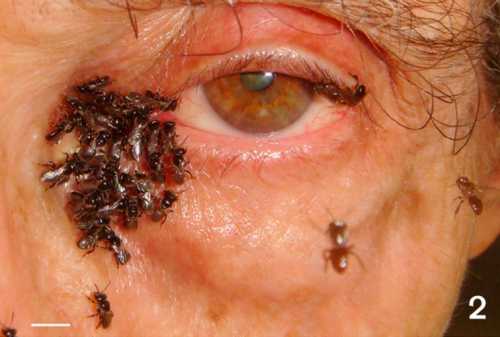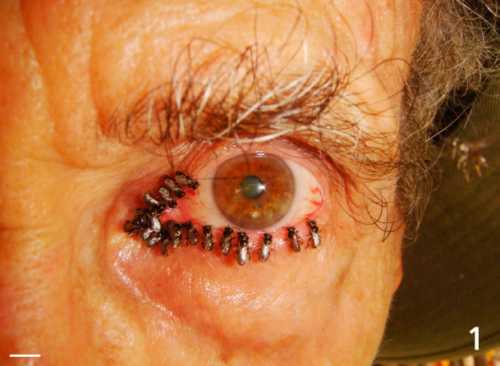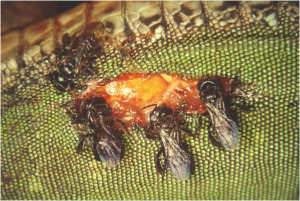How Did Sweat Bees Get Their Name?
The term ‘sweat bee’ is a colloquial name referring to bees known for drinking human sweat, which they gather from arms, hands, the face and wherever they can access it!.
In the US, 'sweat bee' is commonly used in connection with bees occupying the Lasioglossum genus and Augochlorini tribe, belonging in the Halictidae bee family.
Not all Lasioglossum species are observed to drink human sweat, and as an aside, the name ‘Lassioglossum’ has its origins in Greek, meaning ‘hairy tongue’1, and another common name for this genus of bees is the ‘Base-banded furrow bee’2.
Interesting Quick Facts
1. Some bee species really do drink human sweat!
2. In some parts of the world, other bees drink not only sweat, but also tears! Thankfully, these bees are stingless, and very small, but given the chance, they will group around the eyes of humans to get at the watery eye fluid!
3. The phenomenon of insects feeding on sweat is called "sudophagy"8,9.
4. The phenomenon of insects feeding on tears is called "lachryphagy"5,8,9.
Why Do Sweat Bees Drink Human Sweat?
As far as I am aware, there is no firm answer to this question. It is, however, notable that bees of different species will drink what humans consider to be 'dirty water'.
For example, bees have been observed to drink from muddy puddles and water containing animal urine, even when an alternative source of clean water is available, (you can read more about this on my page Do Bees Drink Water?).
Similarly, Boggs and Dau (2004) showed that montane butterfly species have feeding preferences among mud, herbivore dung, and carnivore dung3.
Despite continuing to forage for nectar and pollen, scientists postulate that bees seek particular micronutrients and minerals in brackish water.
Human sweat, which is mostly water, is also known to contain traces of various elements, including4:
- Sodium
- Chloride
- Potassium
- Calcium
- Magnesium
- Iron
- Zinc
- Copper
Do Sweat Bees Sting?
Sweat bees of the Lasioglossum genus are mostly very tiny, and can easily be swiped accidentally, caught in the hair, or mistaken for a small fly or biting insect and promptly swatted.
This action, not surprisingly, can provoke a stinging incident, though it would seem the pain level from the sting of a Lasioglossum is relatively weak, with Lasioglossum species having the lowest score of all bees compared on the Schmidt Sting Pain Index - see Which Bee Has The Most Painful Sting?
However, an injury or stinging incident can cause the bee to release an alarm pheromone which will only serve to attract yet more sweat bees to the skin2.
Other ‘Sweat Bees’ Of The World?
As stated, the term 'sweat bees' usually applies to members of the Lasioglossum genus and Augochlorini tribe within the Halictidae bee family.
However, other regions of the world, do in a sense, have their ‘sweat bees’.
For instance, studies have described interesting behaviour from stingless bees of the Lisotrigona genus of the Meliponini tribe (bee family: Apidae).
It appears that these bees forage not only for nectar and pollen from flowers, they also drink human sweat as well as tears directly from the eyes of humans.
Lisotrigona bees
Lisotrigona bees feeding on sweat and tears have been
documented in Thailand by Bänziger (2018)5, and Bänziger et al (2009)6, in Sri Lanka by Karunaratne et al, (2017)7 and in India by Thangham et al (2021)8.
In the 2018 study by Bänziger published by The Natural History Bulletin of the Siam Society (NHBSS), a number of extraordinary photographs of Lisotrigona furva bees sipping tears from the author's eyes were included.
The Siam Society have very kindly provided permission for me to use two of the photographs below, for which I am very grateful, and express my thanks:


Both images used with permission from the Siam Society. Origin: Natural History Bulletin of the Siam Society, 62 (2): 161–193, 2018.
"CONGREGATIONS OF TEAR DRINKING BEES AT HUMAN
EYES: FORAGING STRATEGIES FOR AN INVALUABLE
RESOURCE BY LISOTRIGONA IN THAILAND
(APIDAE, MELIPONINI)", by Hans Bänziger.
In this fascinating study, Bänziger counted up to 144 tear collecting trips in a day by a single worker!
You may be wondering what it might have felt like to have a small congregation of bees around the eye.
Bänziger describes the experience in his study as mostly causing little disturbance when the bees were engaged in collecting tears. In fact, there were times when the author checked in the mirror that bees were still present.
However, some discomfort was initially felt as the bee positioned herself appropriately at the eyelid, and later, after multiple bees had gathered tears at the eye.
Bänziger found that the presence of several bees felt tickly, and that ultimately, crowded congregations of bees could become unpleasant to 'unbearably irritating'.
Some similar sensations were described by Thangham et al (2021)8 in their study of Lisotrigona bees in India.
The research team initially observed the bees foraging on the sweat of people working in fields before the first author of the study (Thangham) actually volunteered to allow the bees to feed from his sweat and tears for a period of 7 days.
Thangham described the sensation of bees feeding around the eyes as:
“some soft feathers touching the eyes. The bees were very gentle while drinking and did not cause any irritation.”
Why do Lisotrigona collect tears?
Bänziger5 proposes that protein collection is the primary motive for collecting tears specifically, since human tears are 200 times richer in protein than sweat, which would be easier for bees to collect. He states that protein from tears would be easier to digest than protein from pollen, since pollen grains have an 'exine wall' i.e. an out layer on the wall of the pollen grain.
It is certainly interesting that bees continued collecting tears even after rainfall had made other water collecting opportunities available.
Bänziger also notes that tears have bactericidal properties, and furthermore, this is a specialized function for certain members within Lisotrigona furva colonies.
Thangham et al8 hypothesize that this behaviour may represent a transition status from carnivore (meat eater) to highly specialized feeding behaviour of nectarivore (nectar eater) and palynivore (pollen eater).
I presume Thangham et al propose this idea because bees are descended from wasps, which are meat eaters (requiring high protein intake at the larval stage) - see Are Bees And Wasps Related?.
Do Other Bees And Insects Gather Human Sweat And Tears?
Bänziger notes that Apis cerana (the Asiatic honey bee and native to South, Southeast and East Asia) have been observed to drink sweat, and that Centris bees (Apidae, Anthophorini) have been 'documented photographically while hovering in front of the eye of a turtle in Ecuador (DANGLES & CASAS, 2012) and a caiman in Costa Rica (DE LA ROSA, 2014)'.
Other insects are noted to gather various body fluids of living vertebrates. Notably, in their 2013 study: 'Blood, sweat, and tears: a review of the hematophagous, sudophagous, and lachryphagous Lepidoptera', Plotkin and Goddard describe the blood, sweat and tear drinking behaviours of various moth species9.
References
1. Wilson & Messinger-Carril; The Bees In Your Backyard (pg 12), Princeton University Press 2016.
2. Field Guide to the Bees of Great Britain and Ireland by Steven Falk, Bloomsbury 2015.
3. Boggs, C. L., & Dau, B. (2004). Resource specialization in puddling Lepidoptera. Environmental Entomology, 33(4), 1020–1024. https://doi.org/10.1603/0046-225X-33.4.1020
4. Baker LB. Physiology of sweat gland function: The roles of sweating and sweat composition in human health. Temperature (Austin). 2019 Jul 17;6(3):211-259. doi: 10.1080/23328940.2019.1632145. PMID: 31608304; PMCID: PMC6773238.
5. Bänziger, H. (2018). Congregations of tear drinking bees at human eyes: foraging strategies for an invaluable resource by Lisotrigona in Thailand (Apidae, Meliponini). Natural History Bulletin of the Siam Society,62, 161.
6. Bänziger, H., Boongird, S., Sukumalanand, P., & Banziger, S.(2009). Bees (Hymenoptera: Apidae) that drink human tears. Journal of the Kansas Entomological Society, 82(2),135
7. Karunaratne, W., Edirisinghe, J. and Engel, M.S., 2017. First record of a tear-drinking stingless bee Lisotrigona cacciae (Nurse) (Hymenoptera: Apidae: Meliponini), from the central hills of Sri Lanka. Journal of the National Science Foundation of Sri Lanka, 45(1), pp.79–81. DOI: http://doi.org/10.4038/jnsfsr.v45i1.8042
8. Rojeet Thangjam, Shubham Rao, Shashidhar Viraktamath & L. Devarishi Sharma (2021) First report of drinking tear and sweat by Lisotrigona bees (Apidae: Meliponini) from India, Journal of Apicultural Research, DOI: 10.1080/00218839.2021.1933369.
9. Plotkin, D. and Goddard, J. (2013), Blood, sweat, and tears: a review of the hematophagous, sudophagous, and lachryphagous Lepidoptera. Journal of Vector Ecology, 38: 289-294. https://doi.org/10.1111/j.1948-7134.2013.12042.x
If you found this page helpful or interesting, I'd really be grateful if you would share it with others - if not this page, perhaps another, such as Gardening For Bees.
Thank you so much :) .
